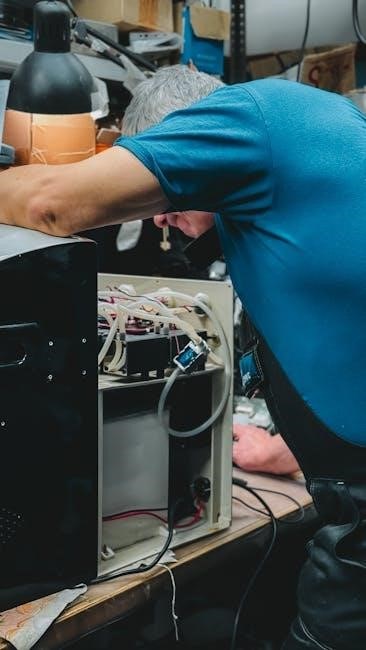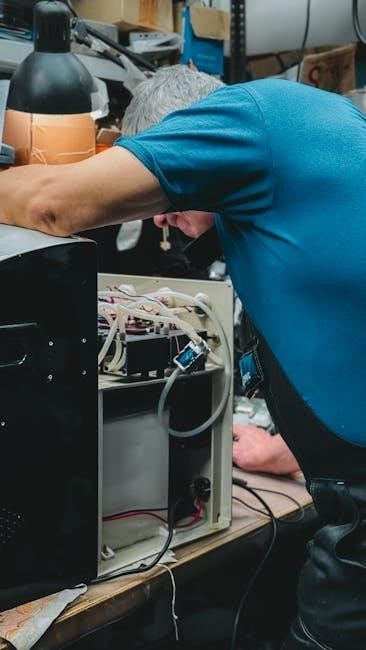Rebuilding a manual transmission is a complex process requiring mechanical skills and attention to detail. It involves disassembling, inspecting, and replacing worn components to restore functionality and performance. This task demands precision and patience, ensuring all parts are correctly reassembled for smooth operation. While challenging, it can be a cost-effective way to extend the life of your vehicle’s transmission.
Overview of Manual Transmission Rebuilding
Manual transmission rebuilding involves systematically disassembling the unit to inspect and replace worn or damaged components. This process includes examining gears, bearings, and synchros, followed by cleaning and reassembling with new seals and gaskets. Proper techniques and tools are essential to ensure smooth gear engagement and prevent future issues. The goal is to restore the transmission to optimal performance, addressing any mechanical failures or wear caused by mileage or misuse.
Importance of Proper Rebuilding Techniques
Proper rebuilding techniques are crucial for ensuring the longevity and functionality of a manual transmission. Incorrect methods can lead to premature wear, gear failure, and costly repairs. Precision in aligning components, torque specifications, and using the right materials is vital. Following established procedures helps maintain the transmission’s performance, reliability, and safety, making it essential to adhere to best practices throughout the rebuilding process to avoid future complications and ensure smooth operation.
Tools and Equipment Needed
Rebuilding a manual transmission requires specialized tools, such as wrenches, screwdrivers, and gear pullers. A clean workspace and protective gear are essential for safety and efficiency.
Essential Tools for Transmission Rebuilding
Rebuilding a manual transmission requires a variety of tools, including wrenches, screwdrivers, and gear pullers. Specialized tools like bearing presses and seal drivers are crucial for installing bearings and seals. A vice and press are essential for handling gears and bearings safely. Pliers, punches, and a set of sockets are also necessary for disassembling and reassembling components. Additionally, a work light, parts organizer, and cleaning supplies are vital for efficiency and precision.
Specialized Equipment Required
Rebuilding a manual transmission often requires specialized equipment like a bearing press, hydraulic press, and transmission jig. A bearing press ensures proper installation of bearings without damage. A hydraulic press is useful for stubborn parts that require extra force. A transmission jig helps align gears and shafts accurately during reassembly. These tools are essential for achieving precise fits and preventing damage to critical components during the rebuild process.

Preparation and Planning
Assess the transmission’s condition, gather repair manuals, and create a detailed plan. Organize tools, parts, and workspace to ensure a smooth, well-structured rebuild process.
Assessing the Condition of the Transmission
Begin by visually inspecting the transmission for damage or wear. Check for fluid leaks, unusual noises, or gear slippage. Test the clutch and gear engagement to identify faulty components. Use diagnostic tools to measure shaft play and bearing wear. Document findings to prioritize repairs and ensure a thorough rebuild. This step is crucial for determining the extent of work needed and avoiding costly oversights during the process.
Creating a Detailed Rebuild Plan
A detailed rebuild plan is essential for a successful manual transmission rebuild. Start by listing all required parts, tools, and materials. Reference the manufacturer’s specifications and repair manuals for guidance. Organize the components in the order they will be installed to ensure a logical workflow. Include a checklist to track progress and avoid missing critical steps. A well-structured plan helps maintain organization and reduces the risk of errors during the rebuild process.
Disassembling the Transmission
Begin by removing external components like the gearshift and clutch cable. Use specialized tools to carefully separate the transmission housing and access internal gears and bearings.
Removing the Transmission from the Vehicle
To remove the transmission, start by securing the vehicle on a lift or jack stands. Drain the transmission fluid and disconnect the battery. Remove the driveshaft and any electrical connectors attached to the transmission. Use a transmission jack to support the unit while detaching it from the engine and chassis. Carefully maneuver the transmission out of the vehicle, ensuring no components are damaged during extraction. Specialized tools and assistance may be required for this step.
Disconnecting Components and Cables
Before removing the transmission, disconnect all connected components and cables. Start by draining the transmission fluid and disconnecting the battery to prevent electrical hazards. Remove the gearshift linkage, clutch cable, and any electrical connectors attached to the transmission. Use appropriate tools to release clips and fasteners. Label each disconnected component for easy reconnection later. Ensure all hoses and lines are capped to prevent contamination. This step requires patience and careful organization to avoid damage or misplacement of parts.
Dismantling the Transmission Housing
Dismantling the transmission housing requires careful use of specialized tools. Start by removing the retaining bolts and gently prying the housing apart. Use a bearing puller to remove pressed bearings and seals. Be cautious not to damage the housing or internal components during disassembly. Mark the position of bearings and other critical parts for proper reassembly. Ensure all components are clean and free from debris before proceeding to inspection.

Inspecting and Cleaning Components
Inspecting and cleaning components ensures proper functionality and longevity. Examine gears, bearings, and surfaces for wear or damage. Use solvents to remove grease and debris thoroughly.
Examining Gears and Bearings for Wear
Inspect gears for chipped teeth, scoring, or excessive wear. Check bearings for pitting or uneven surfaces. Measure gear play and ensure smooth rotation. Look for signs of overloading or misalignment. Use magnification tools for detailed scrutiny. Replace any damaged components to prevent further transmission failure. Proper examination ensures reliability and optimal performance after reassembly.
Cleaning and Preparing Parts for Reassembly
Clean all components thoroughly using a solvent to remove grease and debris. Scrub surfaces with a stiff brush to eliminate contaminants. Dry parts completely before applying new lubricants. Inspect for any remaining imperfections. Proper cleaning ensures a smooth, contamination-free reassembly, reducing wear and tear on the transmission. This step is crucial for maintaining optimal performance and longevity of the manual transmission system.

Replacing Worn or Damaged Parts
Replacing worn or damaged parts involves identifying components like bearings and seals. Swap them with genuine or high-quality replacements. Proper installation ensures smooth functionality and long-term durability.
Identifying Parts That Need Replacement
Identifying parts that need replacement involves inspecting gears, bearings, and seals for wear or damage. Look for signs like scoring, pitting, or excessive play. Use a micrometer to measure gear teeth and bearing races. Replace any components showing excessive wear or damage. Pay attention to synchronizers, gear hubs, and shafts, as these are common failure points. Addressing these issues ensures proper transmission function and prevents future breakdowns.
Installing New Bearings and Seals
Installing new bearings and seals requires precision to ensure proper fitment and alignment. Use specialized tools to press bearings into housings and onto shafts. Apply a thin layer of grease to seal surfaces for lubrication. Align seals correctly to avoid leakage. Ensure all components are seated evenly and securely. Proper installation prevents wear and ensures smooth operation, while also protecting against fluid leaks and contamination.
Reassembling the Transmission
Reassembling involves aligning gears and shafts, then installing bearings and seals. Tighten all bolts to specified torque values to ensure proper fitment and functionality.
Aligning and Installing Gears and Shafts
Aligning gears and shafts requires precision to ensure proper meshing and smooth operation. Clean and lubricate all components before installation. Use alignment tools or dial indicators to verify correct positioning. Install gears and shafts in the specified order, ensuring all splines and bearings are properly seated. Secure components with the appropriate fasteners, tightening to manufacturer-recommended torque specifications. Double-check alignment before finalizing the assembly to prevent damage or wear during operation.
Reattaching Components and Cables
Reattaching components and cables requires careful alignment to ensure proper function. Secure the gear shifter, clutch cable, and other external components, ensuring they are properly seated and adjusted. Use torque specifications for bolts and fasteners to avoid damage. Lubricate moving parts and test each component for smooth operation. Double-check all connections to ensure they are secure and functioning correctly before final assembly.
Testing the Rebuilt Transmission
Testing involves checking for leaks, proper gear engagement, and smooth operation. Ensure all functions work seamlessly, verifying clutch and shifter performance under various conditions for optimal reliability.
Checking for Leaks and Proper Functionality
After reassembling the transmission, inspect for any signs of leaks around seals and gaskets. Ensure all fluid levels are correct and test the transmission by cycling through gears. Verify smooth operation, checking for unusual noises or vibrations. Proper functionality is crucial for reliable performance, so thorough testing under various conditions is essential to confirm the rebuild’s success and durability.
Testing Gear Engagement and Smooth Operation
Once the transmission is reassembled, test gear engagement by cycling through all gears, ensuring smooth transitions without slipping or hesitation. Check for proper synchronization and quiet operation. Test both low and high gears under load to confirm functionality. A well-lubricated system and correct alignment are crucial for seamless performance. This step ensures the transmission operates efficiently and reliably, free from mechanical issues.
Maintenance and Upkeep
Regular maintenance is crucial to ensure long-term performance. Schedule periodic fluid changes and inspections to prevent wear and tear, addressing issues before they escalate.
Regular Maintenance to Prevent Future Issues
Regular maintenance is essential to ensure the longevity and optimal performance of a rebuilt manual transmission. Consistent checks of transmission fluid levels, gear engagement, and shaft seals help identify potential issues early. Inspect for signs of wear or leaks, and replace worn components promptly. Adhering to a maintenance schedule can prevent major repairs and ensure smooth operation over time.
fluid Changes and Inspection Schedules
Fluid Changes and Inspection Schedules
Regular fluid changes are critical for maintaining a manual transmission’s health. Replace the fluid every 30,000 to 60,000 miles, using the manufacturer-recommended type. Inspect the fluid level and consistency during routine checks. Check for signs of contamination or degradation, and ensure all seals and gaskets are intact. A well-maintained fluid system prevents wear and ensures smooth gear engagement. Always consult the vehicle’s service manual for specific schedules and guidelines.
Common Mistakes to Avoid
Common mistakes include rushing the process, ignoring manufacturer specifications, and using improper tools. Overlooking small details like cleaning or alignment can lead to premature wear and failure.
Overlooking Critical Inspection Steps
Overlooking critical inspection steps can lead to premature wear and failure. Failing to examine gears, bearings, and seals for wear can result in poor performance post-rebuild. Neglecting to check for metal shavings or contamination in components can cause further damage. Proper inspection ensures all parts are in good condition before reassembly. Always use precise gauges and tools to measure wear accurately. Skipping these steps risks a faulty transmission rebuild.
Improper Reassembly Techniques
Improper reassembly techniques can lead to transmission failure. Misaligned gears, incorrectly installed bearings, or improperly tightened fasteners can cause catastrophic damage. Using the wrong tools or failing to follow torque specifications can compromise the rebuild. Ensuring accurate alignment of shafts and gears is critical. Always refer to the manufacturer’s guidelines and use precision tools to avoid errors. Sloppy workmanship can result in noisy operation, slipping gears, or complete transmission failure shortly after rebuild.
DIY vs. Professional Rebuilding
Rebuilding a manual transmission can be a cost-effective DIY project for skilled enthusiasts but may require professional expertise for complex or high-performance transmissions. Weighing time, tools, and experience is crucial.
Pros and Cons of DIY Transmission Rebuilding
Rebuilding a manual transmission yourself can be cost-effective and rewarding, allowing for customization. However, it requires mechanical expertise and specialized tools. Errors can lead to costly repairs or transmission failure. DIY enthusiasts may find it satisfying, but the time investment and risk of complications are significant. Professional help is often recommended for complex or high-performance transmissions to ensure reliability and longevity.
When to Seek Professional Assistance
If you lack mechanical expertise or experience with transmission rebuilding, it’s advisable to seek professional help. Complex issues like gear damage or hydraulic system problems often require specialized tools and knowledge. Professionals ensure precise reassembly and proper functionality, minimizing the risk of future failures. Time constraints or high-performance needs also make professional assistance the best option for reliable and efficient transmission rebuilding.
Troubleshooting Common Issues
Common issues after rebuilding include leaks, noisy gears, or slipping. Check for proper seal installation, gear alignment, and fluid levels to ensure smooth operation and reliability.
Identifying and Resolving Post-Rebuild Problems
After rebuilding, test the transmission thoroughly. Common issues include leaks, noisy gears, or slipping. Inspect seals for proper installation and check gear alignment. If gears slip, adjust the clutch or check for worn synchronizers. Use specialized tools to measure gear wear. Addressing these problems early ensures reliable performance and prevents further damage. Systematic troubleshooting is key to resolving issues effectively and avoiding costly rework.
Addressing Noisy or Slipping Gears
Noisy or slipping gears indicate potential issues with gear engagement or wear. Inspect gears for damage or excessive wear. Replace worn-out gears or bearings promptly. Ensure synchronizers are functioning correctly. If gears slip, check the clutch for proper adjustment or replacement. Lubricate components adequately and verify gear alignment during reassembly. Early intervention prevents further damage and restores smooth transmission operation, ensuring optimal performance and longevity of the manual transmission system.

Cost and Time Considerations
Rebuilding a manual transmission can be cost-effective compared to buying new, but expenses vary based on parts and transmission type. Professional labor adds to the cost for those not DIY-ing. Time investment is significant, often requiring several days, especially for novices lacking specialized tools and expertise. Proper planning and preparation are crucial to manage both budget and time effectively for a successful rebuild.
Estimating the Cost of Parts and Tools
The cost of rebuilding a manual transmission varies depending on the type of transmission and the quality of parts used. Basic rebuild kits, including bearings and seals, can range from $300 to $800. Additional components like gears or synchros may increase expenses. Specialized tools, such as a press or bearing puller, can add $100 to $300. DIY rebuilders may save on labor costs, while professional services can double the total expense. Comparing suppliers and considering used or refurbished parts can help reduce costs.
Understanding the Time Investment Required
Rebuilding a manual transmission is a time-intensive process that demands careful planning and execution. The average time required can range from 15 to 30 hours, depending on the individual’s mechanical expertise and the complexity of the transmission. Novice rebuilders should allocate additional time for research and troubleshooting. Proper preparation and organization are crucial to avoid delays and ensure a smooth workflow throughout the project.

Safety Precautions
Always wear protective gear, secure the vehicle properly, and use appropriate tools to avoid injuries. Ensure a clean, well-lit workspace and follow safety guidelines when handling hazardous materials.
Ensuring a Safe Working Environment
Always wear protective gear, including gloves, safety glasses, and a face mask. Ensure proper ventilation and keep flammable materials away. Organize tools neatly and secure the vehicle on jack stands. Be mindful of sharp edges and heavy components. Regularly inspect equipment for damage and maintain a clean workspace. Keep a fire extinguisher and first aid kit nearby. Never work near open flames or sparks when handling hazardous materials like transmission fluid or cleaning solvents.
Handling Hazardous Materials and Tools
When rebuilding a manual transmission, handle hazardous materials like transmission fluid and cleaning solvents with care. Wear protective gloves and goggles to prevent skin and eye irritation. Ensure proper ventilation to avoid inhaling fumes. Store chemicals in labeled, sealed containers and dispose of them according to regulations. Use tools safely, avoiding over-tightening or applying excessive force, which can damage components or cause injury. Regularly inspect tools for wear and damage before use.
Rebuilding a manual transmission is a rewarding process that requires patience and dedication. With proper tools and techniques, you can restore your transmission to optimal performance, ensuring smooth and reliable operation for years to come.
Final Thoughts on Successful Transmission Rebuilding
Rebuilding a manual transmission is a challenging yet rewarding endeavor. By carefully planning, executing precise repairs, and following established guidelines, you can achieve a successful rebuild. Patience and attention to detail are key to ensuring long-term reliability. The satisfaction of restoring your transmission to peak performance makes the effort worthwhile; Stay organized, use quality parts, and don’t hesitate to seek guidance when needed for the best results.
Encouragement for Future DIY Projects
Rebuilding a manual transmission is a significant achievement that builds mechanical skills and confidence. This experience empowers you to tackle future DIY projects with enthusiasm and knowledge. Embrace the satisfaction of restoring your vehicle and apply these skills to other automotive or mechanical endeavors. DIY projects not only save money but also foster a sense of accomplishment and self-reliance. Keep exploring, learning, and taking on new challenges to grow your expertise and enjoyment of hands-on work.



